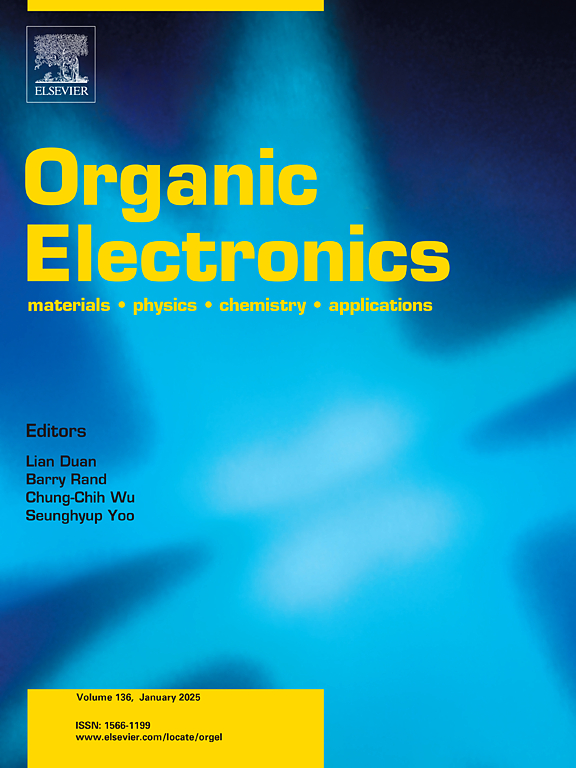碳基钙钛矿太阳能电池通过体和表面协同钝化效应增强光伏性能
IF 2.6
4区 工程技术
Q3 MATERIALS SCIENCE, MULTIDISCIPLINARY
引用次数: 0
摘要
尽管效率显著提高,但碳基钙钛矿太阳能电池(PSCs)的长期稳定性仍然是一个关键挑战。钙钛矿薄膜的钝化处理已被证明可以显着提高PSCs的性能,包括功率转换效率(PCE)和长期稳定性。本研究利用具有双齿基团的小分子2-氨基-5-(三氟甲基)吡啶(5-TFMAP)与2-苯基乙胺碘化物(PEAI)一起钝化碳基PSCs中CH3NH3PbI3薄膜的晶界和表面。PEAI的氨基、5-TFMAP的两个富电子氮原子和吡啶环上的氨基都与缺配的Pb2+有很强的相互作用,5-TFMAP的三氟甲基可以提高钙钛矿膜的疏水性。结果表明,双钝化后碳基PSCs的最佳PCE为15.2%,而控制装置的效率为11.2%。此外,经过双重钝化处理的PSCs的长期稳定性得到了显著增强,在室温下相对湿度约为35%的条件下储存1200 h后,PCE仍保持其初始值的80%。PEAI和5-TFMAP分别钝化了钙钛矿薄膜的本体和表面,有效地降低了缺陷密度,提高了载流子输运,减少了非辐射复合。这项工作为采用联合钝化技术提高碳基psc的PCE和稳定性提供了有价值的见解。本文章由计算机程序翻译,如有差异,请以英文原文为准。

Enhanced photovoltaic performance of carbon-based perovskite solar cells through synergetic passivation effects via bulk and surface
Despite significant efficiency improvements, the long-term stability of carbon-based perovskite solar cells (PSCs) remains a critical challenge. Passivation treatment of perovskite films has been proven to considerably improve the performance of PSCs, including power conversion efficiency (PCE) and long-term stability. This study utilizes a small molecule 2-amino-5-(trifluoromethyl) pyridine (5-TFMAP) with bidentate groups, in conjunction with 2-phenylethanamine iodide (PEAI), for passivating both the grain boundaries and surface of CH3NH3PbI3 films in carbon-based PSCs. The amino group of PEAI, the two electron rich nitrogen atoms and amino group on the pyridine ring of 5-TFMAP all have strong interactions with the under-coordinated Pb2+, and trifluoromethyl of 5-TFMAP can improve the hydrophobicity of perovskite films. As a result, the optimal PCE of the carbon-based PSCs after dual passivation is 15.2%, while the efficiency of the control device is 11.2%. In addition, the long-term stability of PSCs treated with dual passivation is significantly enhanced, with the PCE retaining 80% of its initial value after 1200 h of storage at room temperature under a relative humidity of approximately 35%. The remarkable performance of the as-fabricated cells can be attributed to the combined effect of PEAI and 5-TFMAP, which separately passivate the bulk and surfaces of perovskite films, effectively decreasing defect density, improving carrier transport, and reducing nonradiative recombination. This work provides valuable insights towards improving the PCE and stability of carbon-based PSCs by employing combined passivation techniques.
求助全文
通过发布文献求助,成功后即可免费获取论文全文。
去求助
来源期刊

Organic Electronics
工程技术-材料科学:综合
CiteScore
6.60
自引率
6.20%
发文量
238
审稿时长
44 days
期刊介绍:
Organic Electronics is a journal whose primary interdisciplinary focus is on materials and phenomena related to organic devices such as light emitting diodes, thin film transistors, photovoltaic cells, sensors, memories, etc.
Papers suitable for publication in this journal cover such topics as photoconductive and electronic properties of organic materials, thin film structures and characterization in the context of organic devices, charge and exciton transport, organic electronic and optoelectronic devices.
 求助内容:
求助内容: 应助结果提醒方式:
应助结果提醒方式:


